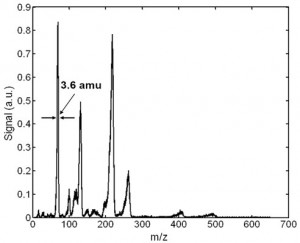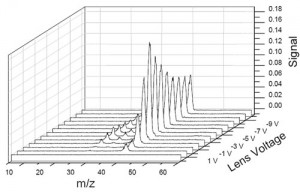Improvements to a Chip-scale Quadrupole Mass Filter for Portable Mass Spectrometry

Figure 1: Mass spectrum for perfluorotributylamine (FC-43) showing a mass range of 650 amu in the first stability region.
Mass spectrometers are powerful analytical instruments that are known to be the gold standard for chemical analysis. The Micro-Gas Analyzer Project attempts to leverage the cost reduction, performance enhancement, and increased portability associated with MEMS to create a microfabricated mass spectrometer for chemical species detection. One of the key components of the mass spectrometer is the mass analyzer, which functions to separate ionized species by their mass-to-charge ratios (m/z). There are various types of mass analyzer with respective advantages and disadvantages, but our group decided to utilize the quadrupole mass filter due to its inherent robustness.

Figure 2: Mass spectrum for argon with trace leakage of air at various inlet lens voltages in the first stability region.
Various attempts at making MEMS-based linear quadrupoles have met with varying degrees of success [1] [2] [3] [4]. Our group devised a new class of chip-scaled quadrupole mass filter that utilizes square electrodes to address the issue of mass producibility, a property not readily achieved with the other technologies. The proof-of-concept device demonstrated a mass range of 250 amu when operated in the first stability region and a maximum resolution of ~40 when operated in the second stability region [5].
A new improved version of the device demonstrated an increased mass range of up to 650 amu in the first stability region and a resolution of ~90 when operated in the second stability region [6]. Additionally, we demonstrated the functionality of integrated ion optics. The major improvement in the new version was a different process flow that raised the yield, electrical breakdown voltage, and structural robustness of the device. In future work, we plan on modifying the mask layout and device dimensions to further improve the performance through using a smaller device radius, minimizing the parasitic capacitances, and including prefilters for enhanced transmission.
References
- M. Geear, R.R.A. Syms, S. Wright, and A.S. Holmes, “Monolithic MEMS Quadrupole mass spectrometers by deep silicon etching,” Journal of Microelectromechanical Systems, vol. 14, no. 5, pp. 1156-1166, Oct. 2005. [↩]
- J.J. Tunstall, S. Taylor, R.R.A. Syms, T. Tate, and M.M. Ahmad, “Silicon micromachined mass filter for a low-power, low-cost quadrupole mass spectrometer,” in Proc. IEEE Eleventh Annual International Workshop on Micro Electro Mechanical Systems, 1998, pp. 438-442. [↩]
- L.F. Velásquez-García, K. Cheung, and A.I. Akinwande, “A versatile MEMS quadrupole platform for portable mass spectrometry using the first and second stability regions,” Journal of Microelectromechanical Systems, vol. 17, no. 6, pp. 1430-1438, Dec. 2008. [↩]
- S. Wright, R.R.A. Syms, S. O’Prey, G. Hong, and A.S. Holmes, “Comparison of ion coupling strategies for a microengineered quadrupole mass filter,” Journal of the American Society for Mass Spectrometry, vol. 20, pp. 146-156, 2009. [↩]
- K. Cheung, L.F. Velásquez-García, and A.I. Akinwande, “Fully Batch-Fabricated Linear Quadrupole Mass Filters,” Technical Digest of the 2008 IEEE Solid-State Sensors, Actuators, and Microsystems Workshop, Hilton Head Island SC, USA, pp. 316-319. [↩]
- K. Cheung, L.F. Velásquez-García, and A.I. Akinwande, “High Performance MEMS Square Electrode Quadrupole Mass Filter for Portable Mass Spectrometry,” Technical Digest of the 23rd IEEE International Conference on Micro Electro Mechanical Systems MEMS 2010, Hong Kong SAR, China, pp. 867-870. [↩]